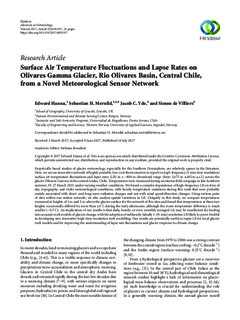| dc.contributor.author | Edward, Hanna | |
| dc.contributor.author | Mernild, Jacob Sebastian Haugaard | |
| dc.contributor.author | Yde, Jacob Clement | |
| dc.contributor.author | De Villiers, Simon Daniel | |
| dc.coverage.spatial | Olivares Gamma Glacier, Rio Olivares Basin, Central Chile | nb_NO |
| dc.date.accessioned | 2019-03-15T10:29:31Z | |
| dc.date.available | 2019-03-15T10:29:31Z | |
| dc.date.created | 2017-07-21T14:02:21Z | |
| dc.date.issued | 2017 | |
| dc.identifier.citation | Hanna, E., Mernild, S. H., Yde, J. C., & Villiers, S. d. (2017). Surface air temperature fluctuations and lapse rates on Olivares Gamma Glacier, Rio Olivares Basin, Central Chile, from a novel meteorological sensor network. Advances in Meteorology, 2017, 1-15. | nb_NO |
| dc.identifier.issn | 1687-9309 | |
| dc.identifier.uri | http://hdl.handle.net/11250/2590215 | |
| dc.description.abstract | Empirically based studies of glacier meteorology, especially for the Southern Hemisphere, are relatively sparse in the literature. Here, we use an innovative network of highly portable, low-cost thermometers to report on high-frequency (1-min time resolution) surface air temperature fluctuations and lapse rates (LR) in a ~800-m elevational range (from 3,675 to 4,492 m a.s.l.) across the glacier Olivares Gamma in the central Andes, Chile. Temperatures were measured during an intense field campaign in late Southern summer, 19–27 March 2015, under varying weather conditions. We found a complex dependence of high-frequency LR on time of day, topography, and wider meteorological conditions, with hourly temperature variations during this week that were probably mainly associated with short- and long-wave radiation changes and not with wind speed/direction changes. Using various pairs of sites within our station network, we also analyze spatial variations in LR. Uniquely in this study, we compare temperatures measured at heights of 1-m and 2-m above the glacier surface for the network of five sites and found that temperatures at these two heights occasionally differed by more than ±4°C during the early afternoons, although the mean temperature difference is much smaller (~0.3°C). An implication of our results is that daily, hourly, or even monthly averaged LR may be insufficient for feeding into accurate melt models of glacier change, with the adoption of subhourly (ideally 1–10-min) resolution LR likely to prove fruitful in developing new innovative high-time-resolution melt modelling. Our results are potentially useful as input LR for local glacier melt models and for improving the understanding of lapse rate fluctuations and glacier response to climate change. | nb_NO |
| dc.language.iso | eng | nb_NO |
| dc.publisher | Hindawi Limited | nb_NO |
| dc.rights | Navngivelse 4.0 Internasjonal | * |
| dc.rights.uri | http://creativecommons.org/licenses/by/4.0/deed.no | * |
| dc.title | Surface Air Temperature Fluctuations and Lapse Rates on Olivares Gamma Glacier, Rio Olivares Basin, Central Chile, from a Novel Meteorological Sensor Network | nb_NO |
| dc.type | Journal article | nb_NO |
| dc.type | Peer reviewed | nb_NO |
| dc.description.version | publishedVersion | nb_NO |
| dc.rights.holder | Copyright © 2017 Edward Hanna et al. | nb_NO |
| dc.subject.nsi | VDP::Matematikk og Naturvitenskap: 400::Geofag: 450::Meteorologi: 453 | nb_NO |
| dc.subject.nsi | VDP::Matematikk og Naturvitenskap: 400::Geofag: 450::Kvartærgeologi, glasiologi: 465 | nb_NO |
| dc.source.pagenumber | 15 | nb_NO |
| dc.source.volume | 2017 | nb_NO |
| dc.source.journal | Advances in Meteorology | nb_NO |
| dc.identifier.doi | 10.1155/2017/6581537 | |
| dc.identifier.cristin | 1482765 | |
| cristin.unitcode | 203,5,4,0 | |
| cristin.unitname | Avdeling for ingeniør- og naturfag - Sogn og Fjordane | |
| cristin.ispublished | true | |
| cristin.fulltext | original | |
| cristin.qualitycode | 1 | |

